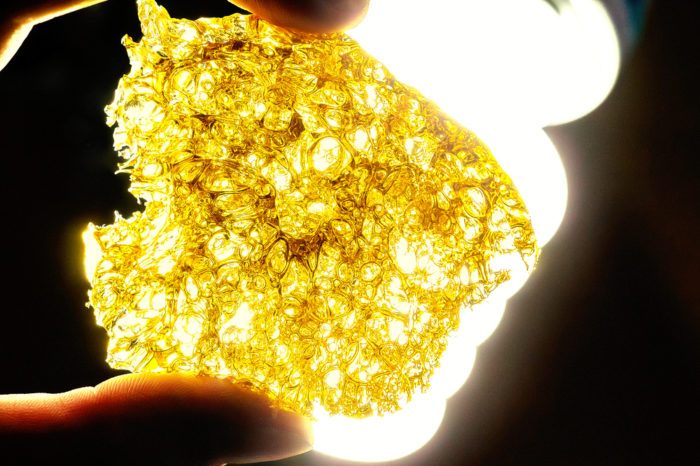BHO is not something you make at home without safety equipment or preparation.
Butane Hash Oil (BHO) is a solvent-based cannabis extract. The extraction of cannabinoids and terpenes takes place using butane, heat, and pressure. The resulting BHO is a golden-yellow, honey-like extract that distills many of the essential medicinal properties of the plant.
What Is Butane Hash Oil?
Butane Hash Oil (BHO) is a form of cannabis concentrate that gets its name from the gas solvent butane. The extraction of the cannabis plant’s active medicinal compounds occurs using butane in a temperature-controlled and pressurized environment.
Light to dark yellow in color, BHO has a consistency that ranges from something as viscus as oil to something approaching the feeling of glass. BHO extracts are often extremely potent and can provide a strong medicated effect; something those with low tolerances to THC should be aware of.
Butane hash oil comes in a variety of forms, and the most commonly available types are shatter, crumble, budder, wax, and sap.
How to Make Butane Hash Oil
To make BHO, pack plant material into a tube before introducing butane. Under controlled environmental conditions — temperature and pressure — the butane extracts the targeted medicinal compounds into a vapor. The distillation of that vapor is the next step before purging it to ensure there is no exposure to the butane for the consumer. After all, the gas is toxic to humans at high enough levels.
In the early days, open blasting was the most common form of BHO production. The main problem associated with this technique was that there was nothing to contain the flammable butane. This made it highly dangerous to work with.
In more recent times, to combat the issue and help keep the solvent contained during extraction, closed-loop systems have become the norm.

Closed-Loop BHO Extractor
In a closed-loop system, containing the butane safely within chambers is the norm to ensure no leakage. It’s a trusted technique in use in the perfume and food additive industries for years. However, it’s only recently become popular in the cannabis industry.
In closed-loop systems, butane rests in pressurized tanks before getting to mix with the plant material. A series of valves and clamps help ensure that the solvent remains pressurized during the process. And as the solvent passes through the plant material, cannabinoids and terpenes along with other beneficial medicinal compounds evaporate off into a vapor.
By distilling the vapor at the other end after extraction, the original plant compounds form into a new concentrated form that’s rich in medicinal compounds.
An additional advantage of closed-loop systems is that the butane is reusable — something that leads to significant cost reductions in larger operations.
The Best Butane for BHO Extractions
Firstly, before discussing chemistry, a disclaimer. Accidents often occur when working with butane. Be very cautious if you decide to use it and only do so after some thorough research. Ensure a clean working area that’s well ventilated. It’s also highly advisable to wear protective gear such as gloves, safety glasses, and flame-retardant clothing.
The choice of butane used in an extraction system can make a significant difference. Butane not only affects how efficiently the extraction of compounds takes place, but also how the end extract will taste. The butane used in the extraction process will also determine the color of the resulting extract which typically ranges from light to dark yellow.
When it comes to selecting butane, there are two main types — n-butane and iso-butane. With regard to absolute purity, there’s an important difference. Butane consists of a blend of gases at varying purities, and iso-butane solutions commonly include fillers to lower costs.
The best options on the market are n-butane solutions that underwent additional filtration for extra purity. While such types of butane are more expensive, they’ll result in a cleaner-tasting and more potent extract that should be easier to purge.
Puretane Pure BHO Butane is a triple distilled form of butane. It’s known to provide a clean extract and is one form of butane popular among many BHO enthusiasts.

How to Consume BHO Edibles and Concentrates
Whether used in edibles or in concentrate form, BHO offers up a potent medicated effect. Edibles infused with BHO are particularly common. Since it’s very convenient to add BHO concentrates to food and drinks without any timely prep work.
By simply noting the percentage of THC present in a particular BHO extract, calculating the equivalent dose of each edible is possible to a surprisingly accurate degree with some basic math.
For those who prefer to consume BHO concentrates by other means, dabbing is the most common way. Dabbing is a constantly evolving art form and the recent wave of legalization has produced all manner of rigs to tailor the experience.
One notable development in more recent times is that of low-temperature dabbing. As the name suggests, low-temperature dabbing occurs at lower temperatures — usually between three-hundred and fifty and four-hundred and fifty degrees Fahrenheit. Dabbing at low temperatures avoids the direct burning of the all-important cannabinoids and terpenes. This results in a smoother and more flavorful experience that’s less harsh on the throat and lungs.
A Word on Quality BHO Extracts
As is the case with any concentrates, consumers must be aware that every compound extracted becomes more concentrated in the final product. While the ratios of the useful medicinal compounds are greatly increased in concentrates, so too are the unwanted compounds. That long list may include solvent residues, pesticide residues, and heavy metals.
In legal jurisdictions, strict laws are in place to ensure unsafe quantities of these compounds are not present. Those purchasing BHO outside of legal jurisdictions, or those going the DIY route, must be aware of the issues posed by suboptimal flower and improper purging of butane.
But, for those that source a quality BHO extract capable of preserving a wide range of the original plant compounds, there’s little to worry about.





